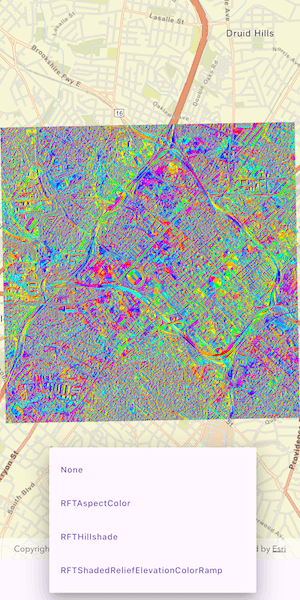Display a raster on a map and apply different rendering rules to that raster.

Use case
Raster images whose individual pixels represent elevation values can be rendered in a number of different ways, including representation of slope, aspect, hillshade, and shaded relief. Applying these different rendering rules to the same raster allows for a powerful visual analysis of the data. For example, a geologist could interrogate the raster image to map subtle geological features on a landscape, which may become apparent only through comparing the raster when rendered using several different rules.
How to use the sample
Run the sample and use the drop-down menu at the bottom to select a rendering rule.
How it works
- Create an
ImageServiceRasterusing a URL to an online image service. - After loading the raster, use
imageServiceRaster.serviceInfo?.renderingRuleInfosto get a list ofRenderingRuleInfosupported by the service. - Choose a rendering rule info to apply and use it to create a
RenderingRule. - Create a new
ImageServiceRasterusing the same URL. - Apply the rendering rule to the new raster using
imageServiceRaster.renderingRule = RenderingRule.withRenderingRuleInfo(renderingRuleInfo). - Create a
RasterLayerfrom the raster for display.
Relevant API
- ImageServiceRaster
- RasterLayer
- RenderingRule
About the data
This raster image service contains 9 LAS files covering Charlotte, North Carolina's downtown area. The lidar data was collected in 2007. Four Raster Rules are available for selection: None, RFTAspectColor, RFTHillshade, and RFTShadedReliefElevationColorRamp.
Additional information
Image service rasters of any type can have rendering rules applied to them; they need not necessarily be elevation rasters. See the list of raster function objects and syntax for rendering rules in the ArcGIS REST API documentation.
Tags
raster, rendering rules, visualization
Sample Code
// Copyright 2025 Esri
//
// Licensed under the Apache License, Version 2.0 (the "License");
// you may not use this file except in compliance with the License.
// You may obtain a copy of the License at
//
// https://www.apache.org/licenses/LICENSE-2.0
//
// Unless required by applicable law or agreed to in writing, software
// distributed under the License is distributed on an "AS IS" BASIS,
// WITHOUT WARRANTIES OR CONDITIONS OF ANY KIND, either express or implied.
// See the License for the specific language governing permissions and
// limitations under the License.
//
import 'package:arcgis_maps/arcgis_maps.dart';
import 'package:arcgis_maps_sdk_flutter_samples/common/common.dart';
import 'package:flutter/material.dart';
class ApplyRasterRenderingRule extends StatefulWidget {
const ApplyRasterRenderingRule({super.key});
@override
State<ApplyRasterRenderingRule> createState() =>
_ApplyRasterRenderingRuleState();
}
class _ApplyRasterRenderingRuleState extends State<ApplyRasterRenderingRule>
with SampleStateSupport {
// Create a controller for the map view.
final _mapViewController = ArcGISMapView.createController();
// A map with a streets basemap.
final _map = ArcGISMap.withBasemapStyle(BasemapStyle.arcGISStreets);
// The web URI to the "CharlotteLAS" image service containing LAS files for Charlotte, NC downtown area.
final _charlotteLASUri = Uri.parse(
'https://sampleserver6.arcgisonline.com/arcgis/rest/services/CharlotteLAS/ImageServer',
);
// An array of raster layers, each with a different rendering rule.
List<RasterLayer> _rasterLayers = [];
// The selected raster layer from the dropdown menu.
RasterLayer? _selectedRasterLayer;
// The viewpoint for zooming the map view to a layer's extent.
late Viewpoint _viewpoint;
// A flag for when the map view is ready and controls can be used.
var _ready = false;
@override
Widget build(BuildContext context) {
return Scaffold(
body: SafeArea(
top: false,
left: false,
right: false,
child: Stack(
children: [
Column(
children: [
Expanded(
child: ArcGISMapView(
controllerProvider: () => _mapViewController,
onMapViewReady: onMapViewReady,
),
),
buildBottomMenu(),
],
),
LoadingIndicator(visible: !_ready),
],
),
),
);
}
Widget buildBottomMenu() {
return Center(
// A dropdown menu for selecting a rendering rule.
child: DropdownMenu(
hintText: 'Rendering Rule',
trailingIcon: const Icon(Icons.arrow_drop_down),
textStyle: Theme.of(context).textTheme.labelMedium,
width: 250,
initialSelection: _selectedRasterLayer,
onSelected: (rasterLayer) {
setState(() => _selectedRasterLayer = rasterLayer);
setLayer(rasterLayer!);
},
dropdownMenuEntries:
_rasterLayers.map((rasterLayer) {
return DropdownMenuEntry(
value: rasterLayer,
label: rasterLayer.name,
);
}).toList(),
),
);
}
Future<void> onMapViewReady() async {
// Set the map to the map view controller.
_mapViewController.arcGISMap = _map;
// Gets the raster layers when the sample opens.
_rasterLayers = await getRasterLayers();
if (_rasterLayers.isNotEmpty) {
// Load the first raster layer.
await _rasterLayers.first.load();
setLayer(_rasterLayers.first);
}
setState(() => _ready = true);
}
// Sets a given layer on the map and zooms the viewpoint to the layer's extent.
// - Parameter layer: The layer to set.
void setLayer(Layer layer) {
_map.operationalLayers.clear();
_map.operationalLayers.add(layer);
if (layer.fullExtent != null) {
_viewpoint = Viewpoint.fromTargetExtent(layer.fullExtent! as Geometry);
_mapViewController.setViewpoint(_viewpoint);
}
}
// Creates raster layers for all the rendering rules from an image service raster.
// - Returns: An array of new `RasterLayer` objects.
Future<List<RasterLayer>> getRasterLayers() async {
// Creates and loads an image service raster using an image service URL.
final imageServiceRaster = ImageServiceRaster(uri: _charlotteLASUri);
await imageServiceRaster.load();
// Gets the rendering rule infos from the raster's service info.
final renderingRuleInfos =
imageServiceRaster.serviceInfo?.renderingRuleInfos ?? [];
return renderingRuleInfos.map((renderingRuleInfo) {
// Creates another image service raster and sets its rendering rule using the info.
// This is required since the raster can't be loaded when setting its rendering rule.
final imageServiceRaster = ImageServiceRaster(uri: _charlotteLASUri);
imageServiceRaster.renderingRule = RenderingRule.withRenderingRuleInfo(
renderingRuleInfo,
);
// Creates a layer using the raster.
final rasterLayer = RasterLayer.withRaster(imageServiceRaster);
rasterLayer.name = renderingRuleInfo.name;
return rasterLayer;
}).toList();
}
}